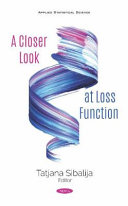Product desciption
A Closer Look At Loss Function Frank Columbus by Frank Columbus 9781536165401, 1536165409 instant download after payment.
The quality loss function, introduced by Japanese engineer, statistician and scientist Dr. Genichi Taguchi in the 1980s, is still one of the most interesting topics in applied industrial statistics and quality engineering and management, which presented a paradigm shift in quality loss and product, process and/or system quality conception. Taguchi emphasized a proactive approach toward quality in terms of embedding quality requirements into the design of product, process and/or system, which highly influenced today's quality approaches such as the 'quality-by-design' concept strongly demanded in the era of the fourth industrial revolution that we are currently facing. This book contributes to a further development, extension and application of the Taguchi's quality loss concept, aiming to overcome limitations of the traditional quadratic quality loss function and to address complex demands and circumstances in a dynamic and globalized contemporary industrial sector. It presents essential issues and heterogeneous complementary aspects of the quality loss function, including the theoretical background and advances as well as different application studies. The opening chapter is dedicated to the quality loss functions used in quality engineering, presenting an in-depth theoretical background of the traditional loss function, the bounded loss function concept, i.e. the reflected normal loss function, and the family of inverted loss functions, and proposing the recently developed loss function types. The second chapter is focused on the Taguchi's and inverted quality loss functions, univariate and multivariate types, and their advances and implications in tackling real, heterogeneous industrial problems in statistical quality and process control. The third chapter considers an application of the quality loss and quality cost concepts at a system level, by introducing the quality policy model of an organization, developed and implemented in a middle-sized manufacturing company in the automotive industry. The fourth chapter deals with the comparison and alignment of the Taguchi's orthogonal arrays and the traditional full factorial approach for experimental design, including also the method for analysis of experimental results, depicted by two use cases from different industrial sectors. The last chapter proposes an advanced quality loss-based method for discrete process parameter optimization that tackles processes characterized by multiple correlated responses. The benefits of its implementation are illustrated on heterogeneous process optimization problems, and comparison with several frequently used optimization methods clearly demonstrates its superiority, effectiveness and applicability in real industrial conditions. Therefore, this book offers a unique combination of two aspects relevant for scientists and statisticians, and engineers and managers, respectively: (i) strong scientific background on the quality loss function, its modifications and extensions, and novel, advanced developments; (ii) hands on approach for application of the quality loss function-based methods designed for product, process and/or system quality improvement in different stages, from the experimental design, via analysis of experimental results and process parameter optimization, toward an organizational quality policy implementation.


